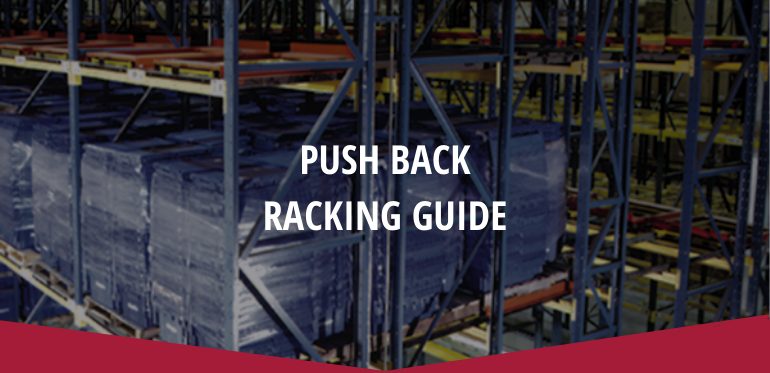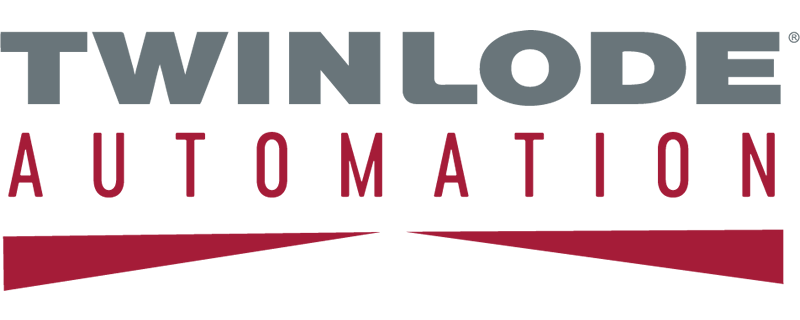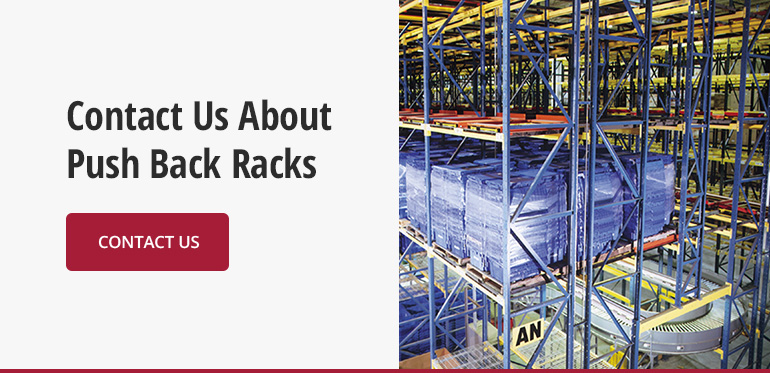
02 May Push Back Racking Guide
Many businesses and distribution operations prefer push back racking systems because they provide significantly more storage than single-deep designs. Push back racks offer an efficient blend of selectivity and density for facilities handling many SKUs in high volumes. Because these systems feature fewer aisles with deeper storage, they provide higher visibility and more efficient retrieval than conventional systems.
What Is Push Back Racking?
Push back racking is a high-density solution designed for storing multiple products. The system’s selectivity and maintenance-free features make back-to-back pallet racking ideal for many business environments. In addition, forklift operators do not need to enter an aisle for loading or unloading, increasing workplace safety, and minimizing damage to the racking system and material handling equipment.
Types of Push Back Racks
At Twinlode Automation, our engineers have years of experience designing push back systems and other racking designs based on an operation’s unique storage needs. Lane depth can vary depending on the application, with most systems featuring lanes capable of holding two to six pallets. Push back racks can easily integrate with other racking system designs to increase picking efficiency and maximize storage space.
Because the last unit loaded into each lane is the first pallet unloaded, these systems support last-in, first-out (LIFO) inventory management systems.
Examples of the most common push back rack designs include:
- Push back with shuttles: The forklift operator loads each pallet onto a shuttle. The shuttle moves along the inclined rails.
- Push back with rollers: When the forklift operator loads the pallets, roller beds move the pallets along the incline.
How Do Push Back Racking Systems Work?
The push back racking system has inclined rails and nesting carts set on the rails. To load, each pallet is placed on a free-rolling carriage and then pushed back by subsequent pallet loading, exposing the next cart. Each pallet on the rack sits on a new cart, and the previous pallets are pushed back.
To unload, gravity moves the pallets gently forward to the aisle, so no reaching or equipment driving into the rack is necessary. When the forklift operator removes the pallet in the picking position, the next pallet behind it takes the previous pallet’s position. This process is repeated with each pallet until the lane is empty.
Each level or lane is independently accessible, requiring fewer aisles and forklifts. Loading and picking are done from the same side for LIFO inventory retrieval. Due to the volume of push back pallet positions in certain systems, some push back systems will have multiple aisles.
Push Back Racking Benefits
Choosing a push back racking system provides benefits like:
- High-density storage: Push back racking increases a facility’s storage capacity compared to double-deep or standard pallet racks. Facilities can gain up to 90% more storage space than traditional selective pallet racking. Storage density is also increased up to 35% since push back racks eliminate an upright at every pallet position.
- Fast loading: Push back racks make the loading and unloading process faster than Drive-In racking. Due to pallets automatically moving to the picking position, forklift operators do not need to reach into the racking. Forklifts also do not enter the structure’s aisle, reducing maneuvering time.
- Enhanced safety: Many push back racks have safety systems in place to control and brake loads. These mechanisms reduce the safety risks of shuttle and roller systems.
- Space saving: High-density storage such as push back racks store palletized loads efficiently while saving space.
- Improved stock rotation: Push back racks improve stock rotation and occupancy. The LIFO system uses the same aisle for loading and unloading single-SKU storage since each level stores a different product.
- Load stability: Side-by-side pallet handling keeps the load stable while improving safety and efficiency.
- Maintenance-free: The sturdy construction of push back racking delivers years of maintenance-free operations.
Push Back Racking System Applications
The versatility and flexibility of a push back system make it a practical solution for nearly any type of storage facility wanting to increase storage capacity, regardless of size or layout. Operations using LIFO inventory systems often consider pushback racks first to optimize logistics. These racking systems are ideal for companies requiring storage for a broad product range and facilities storing items with far-out expiration dates.
Additionally, push back systems work well in extreme environments, including coolers and freezers. These systems are also compatible with standard forklifts and many other models of material-handling equipment.
Push back racks are popular in many applications across a broad industry range, including:
- Perishables
- Automotive
- Staging
- Pharmaceuticals
- Food and beverage
- Manufacturing
 Contact Us About Push Back Racks
Contact Us About Push Back Racks
Push back racking offers the optimal combination of selectivity and storage density. Push back racks designed and implemented by Twinlode Automation help businesses improve productivity through efficient storage. We have several years of experience with push back systems and other pallet rack solutions. Twinlode Automation also offers professional services for implementation, design, and consultation.
Contact us online to learn more about push back pallet racking.




